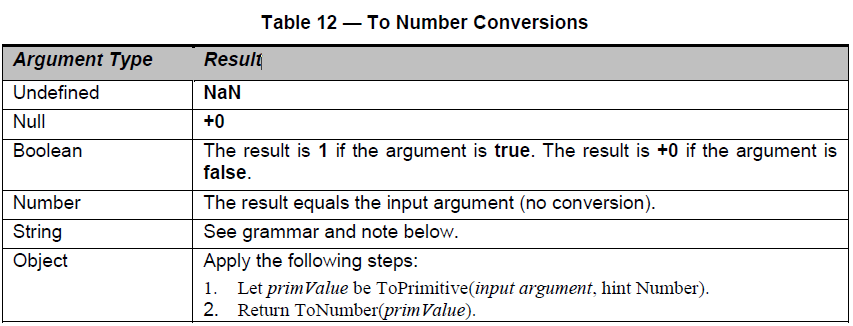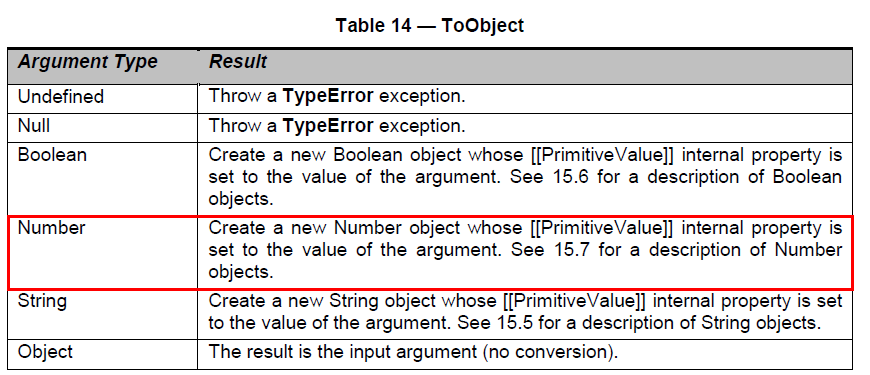JS中不為人知的五種聲明Number的方式簡要概述
編輯:關於JavaScript
1、聲明一個數值類型的變量我看到三種,區別在哪:
復制代碼 代碼如下:
var num = 123; //方式一
var num = Number(123);
var num = new Number(123);
2、方式一明明是個數字字面量,為毛平常我們可以直接在上面調用各種方法,如下:
復制代碼 代碼如下:
var num = 123;
console.log(num.toString());
我嘴角微微一笑:少年你還嫩了點,哪止三種,我知道的至少有五種!!
笑著笑著嘴角開始抽搐,額角開始冒出了冷汗:至少有五種,沒錯,但是。。。區別在哪。。。
懷著老菜鳥特有的矜持和驕傲,我不屑地說:這都不知道,自己查資料去。。。轉過身,開始翻ECMAS - 262(第五版)
一、五種聲明數值類型變量的方式
復制代碼 代碼如下:
//方式一:最常見的方式,通過數字字面量方式聲明
var num = 123;
//方式二:偶爾使用方式,大部分情況下是將字符串轉成數字
var num = Number(123);
//方式三:很少使用,各神書,包括犀牛書,都將其列入不推薦方式
var num = new Number(123);
//方式四:神方式,目前還沒見過人使用
var num = new Object(123);
//方式五:更離奇,更詭異
var num = Object(123);
可以看到,在上5種聲明方式種,方式一不用怎麼說了,平常都是這樣用的;方式三 to 方式五屬於比較的使用,下文會分別說明:
1.五種聲明方式的區別?當你用顫巍巍的手指敲下代碼後,究竟發生了神馬?
2.方式一聲明的明明不是對象,但為什麼平常我們可以在上面調用方法,如toString等?
二、各種聲明方式之間的區別
方式一:var num = 123;
EC5說明:
A numeric literal stands for a value of the Number type. This value is determined in two steps: first, a mathematical value (MV) is derived from the literal; second, this mathematical value is rounded as described below
//.....個人總結摘要:
1.解析變量的值,比如說取出整數部分、小數部分等,因為數字聲明方式還可以為num = .123,num = 123e4等形式
2.對解析出來的值取近似值,比如num = 123.33333333333333...3333333333333333333333333....,這個時候就要取近似值了,具體取近似則規則不展開
3.此種方式聲明的變量,只是個簡單的數字字面量,並不是對象(至於為什麼可以在上面調用toString等方法,後文講解)
方式二:var num = Number(123);
EC5說明:
15.7.1 The Number Constructor Called as a Function
When Number is called as a function rather than as a constructor, it performs a type conversion. 15.7.1.1 Number ( [ value ] )
Returns a Number value (not a Number object) computed by ToNumber(value) if value was supplied, else returns +0.個人總結摘要:
1.此處只是將Number當作一個普通的函數來調用,而不是構造方法,因此返回的不是對象,而是一個簡單的數值
2.本質與方式一相同;相對於方式一的區別在於,需要針對傳入參數的類型,執行不同的類型轉換過程,試圖將參數解析成對應的數值,具體規則如下:

方式三:var num = new Number(123);
EC5說明:
15.7.2 The Number Constructor
When Number is called as part of a new expression it is a constructor: it initialises the newly created object. 15.7.2.1 new Number ( [ value ] )
The [[Prototype]] internal property of the newly constructed object is set to the original Number prototype object, the one that is the initial value of Number.prototype (15.7.3.1).
The [[Class]] internal property of the newly constructed object is set to "Number".
The [[PrimitiveValue]] internal property of the newly constructed object is set to ToNumber(value) if value was
supplied, else to +0.
The [[Extensible]] internal property of the newly constructed object is set to true.個人總結摘要:
1.此處將Number作用構造方法調用,返回的是Number類型的對象,該對象能夠訪問Number的原型屬性以及方法;這樣說可能有些迷惑,後面會說到
復制代碼 代碼如下:
var num = new Number(123);
console.log(typeof num); //輸出:object
console.log(Object.prototype.toString.call(num)); //輸出:[object Number]
3.返回的Number類型對象內部的原始值( [[PrimitiveValue]]),為經過類型轉換後獲得的數字值,具體轉換規則與方式二提到的一致
方式四:var num = new Object(123);
EC5說明:
15.2.2 The Object Constructor
When Object is called as part of a new expression, it is a constructor that may create an object.
15.2.2.1 new Object ( [ value ] )
When the Object constructor is called with no arguments or with one argument value, the following steps are taken:
1.If value is supplied, then
a. If Type(value) is Object, then
1.If the value is a native ECMAScript object, do not create a new object but simply return value.
2.If the value is a host object, then actions are taken and a result is returned in an implementation-dependent manner that may depend on the host object.
b. If Type(value) is String, return ToObject(value).
c. If Type(value) is Boolean, return ToObject(value).
d. If Type(value) is Number, return ToObject(value).
2.Assert: The argument value was not supplied or its type was Null or Undefined.
3.Let obj be a newly created native ECMAScript object.
4.Set the [[Prototype]] internal property of obj to the standard built-in Object prototype object (15.2.4).
5.Set the [[Class]] internal property of obj to "Object".
6.Set the [[Extensible]] internal property of obj to true.
7.Set all the internal methods of obj as specified in 8.12.
8.Return obj.
個人理解說明:
上面洋洋灑灑的貼了好多文字,可能看著有些頭疼,因為通過 new Object(param) 這種方式聲明變量,根據傳入參數具體類型的不同,得到的結果也會有區別,比如說數據類型。這裡面具體轉換的規則,可以忽略不計,我們只看我們目前關系的部分,即上面標紅色的文字,要點有:
1.傳遞了參數,且參數是一個數字,則創建並返回一個Number類型的對象 —— 沒錯,其實等同於方式三
2.該Number對象的值等於傳入的參數,內部的[[prototype]]屬性指向Number.prototype
方式五:var num = Object(123);
EC5說明:
15.2.1 The Object Constructor Called as a Function
When Object is called as a function rather than as a constructor, it performs a type conversion.
15.2.1.1 Object ( [ value ] )
When the Object function is called with no arguments or with one argument value, the following steps are taken:
1.If value is null, undefined or not supplied, create and return a new Object object exactly as if the standard built-in Object constructor had been called with the same arguments (15.2.2.1).
2.Return ToObject(value).
個人理解說明:
1.當傳入的參數為空、undefined或null時,等同於 new Object(param),param為用戶傳入的參數
2.否則,返回一個對象,至於具體轉換成的對象類型,可參見下表;具體到上面的例子,本質等同於new Number(123):

3. 簡單測試用例
復制代碼 代碼如下:
var num = Object(123);
console.log(typeof num); //輸出:object console.log(Object.prototype.toString.call(num)); //輸出:[object Number]
三、var num = 123; 與 var num = new Number(123);
各位先賢哲們告誡我們最好用第一種方式,理由成分,擲地有聲:效率低,eval(num)的時候可能有意外的情況發生。。。巴拉巴拉
拋開上面的雜音,我們這裡要關注的是,為什麼下面的語句不會出錯:
復制代碼 代碼如下:
var num = 123;
console.log(num.toString(num)); //輸出:'123',竟然沒出錯
不是說字面量方式聲明的只是普通的數值類型,不是對象嗎?但不是對象哪來的toString方法調用,這不科學!
好吧,查了下犀牛書,找到了答案:
當用戶通過字面量方式聲明一個變量,並在該變量上調用如toString等方法,JS腳本引擎會偷偷地創建該變量對應的包裝對象,並在該對象上調用對應的方法;當調用結束,則銷毀該對象;這個過程對於用戶來說是不可見的,因此不少初學者會有這方面的困惑。
好吧,我承認上面這段話並不是原文內容,只是個人對犀牛書對應段落的理解,為了顯得更加專業權威故意加了引用標識。。。上面舉的那個例子,可以簡單看作下面過程:
復制代碼 代碼如下:
var num = 123;
var tmp = num;
num = new Number(num);
console.log(num.toString(num));
num = tmp;
(因為昨晚翻規范翻到快1點,實在困的不行,就偷懶了,相信犀牛書不會坑我)
四、寫在後面
Javascript的變量聲明方式、類型判斷等,一直都覺得無力吐槽,上面的內容對於初學者來說,無異於毀三觀;即使對於像本人這樣已經跟Javascript厮守了兩年多的老菜鳥,經常也被弄得稀裡糊塗
簡單總結一下:
1.方式一、方式二本質相同
2.方式三、方式四、方式五本質相同
最後的最後:
文中示例如有錯漏,請指出;如覺得文章對您有用,可點擊“推薦” :)
小編推薦
熱門推薦